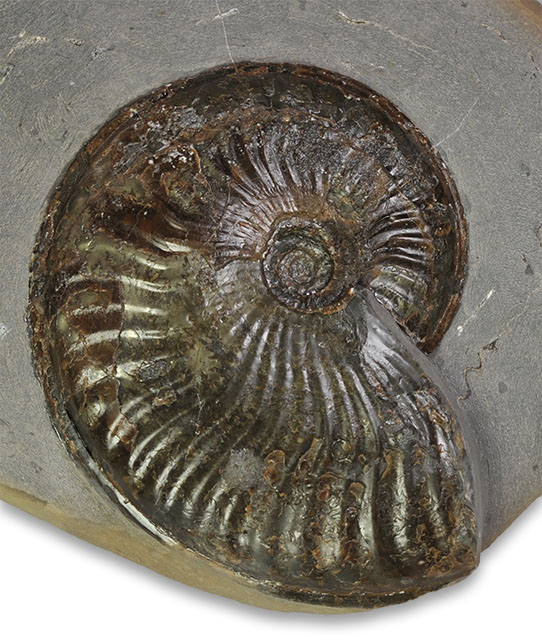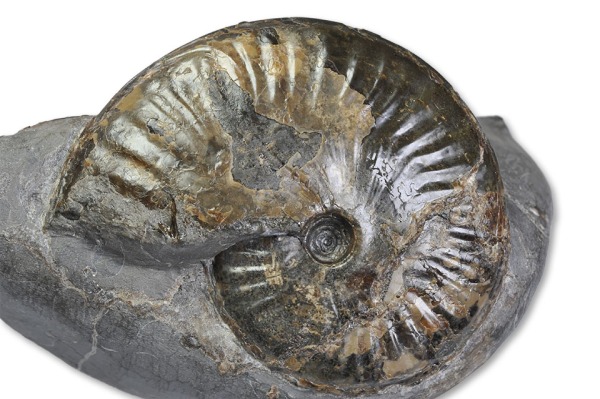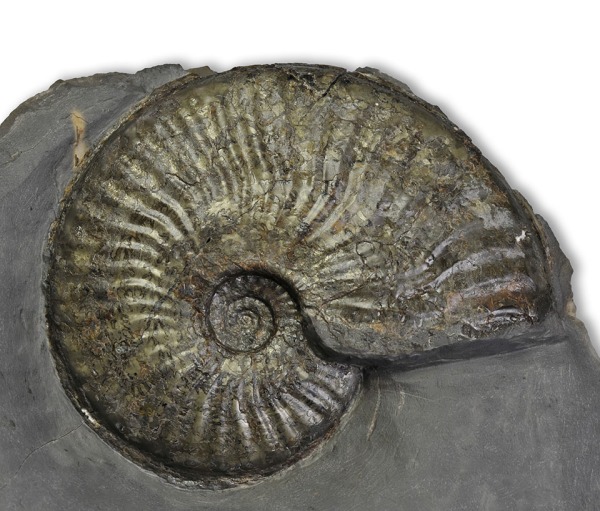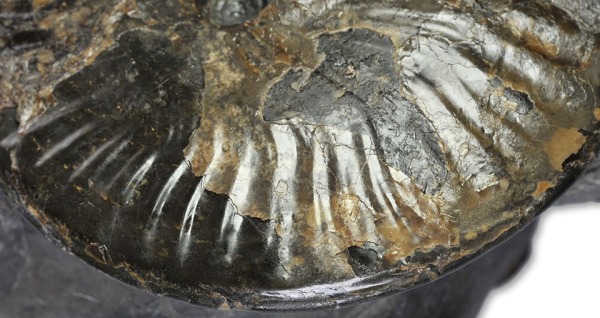Pseudolioceras is a relatively common ammonite with 2 to 3 Yorkshire species, with P. lythense from the bifrons zone (commune & fibulatum subzones) being considered the ancestor of the later, thouarsense zone (striatulum and above subzones) P. boulbiense.
P. subconcavum is at the moment considered to be a synonym of P. lythense but may also be an early form from lower in the commune subzone –
more zonally aligned material is needed for a statistically safe distinction.
The holotype of “P. subconcavum”, which can be seen at Whitby museum, differs from P. lythense in having thicker whorls and deeper furrows along the keel.
This form seems to be relatively rare – I may have a very small one in my collection, but as with most small non-adult ammonites,
this identification is really more wishful thinking than fact – I will not post it here, for a good picture see the excellent Whitby museum type & figured fossils catalog web page for this ammonite at
http://www.whitbymuseum.org.uk/type/grp04/sim214.htm
Large, complete, uncrushed specimen of Pseudolioceras are rather rare due to the apparent fragility of the body chamber –
most of the time you find only specimen with an uncrushed phragmocone and a crushed body chamber
Telling the difference between P. lythense and P. boulbiense is really rather simple and apart from the umbilicus also involves the bed and location you found it.
The following probabilities give some kind of a guideline :
- If it´s above 7 cm, it is more likely to be a P. lythense – P. boulbiense above this size is rare.
- If you found it in a striatulum subzone nodule at Ravenscar, it is most likely P. boulbiense
- If you found it anywhere else other than Ravenscar it is most likely to be P. lythense
since the striatulum subzone is only really well exposed at Ravenscar – of course there may be exceptions. - If you find it together with other ammonites of the same species, or even ammonite of other species, it is most likelyP. boulbiense.
This is really somewhat obvious considering the previous critera – P. lythense is most often a “one ammonite per nodule” find,
as they typically are in the alum shales (I can’t really remember if I have ever seen a Pseudolioceras lythense with another ammonite, I’m sure there must be some…)
whereas P. boulbiense occurs most often associated with other specimen of the same species, sometimes even dozens or Grammoceras or even the odd Nodicoeloceras.

Pseudolioceras boulbiense loves company : Small Nodicoeloceras (2 cm) sitting on top of 5.5 cm P. boulbiense + severall small Pseudolioceras
The U/D ration (width of umbilicus / diameter of shell) is usually smaller with P. boulbiense, with P. lythense´s wider umbilicus (with quite some variation) you can usually see more of the inner whorls when you look into the umbilicus as with P. boulbiense, where the inner whorls are just to be seen as a thin ledge inside the umbilicus, with the 7 cm specimen shown above, the width of this ledge is just 1 mm.
The umbilical walls of P. boulbiense are just slightly beveled, visible best with smaller specimen, whereas the umbilicals walls of P. lythense are vertical or even undercut.
Ribbing is also different, with P. lythense the ribs visibly swing forward towards the venter, whereas with P. boulbiense, you have to look very hard to see that –
the ribs “stop” more abruptly before the venter, there is only a hint of a rib swinging forward.
You can see this best in a direct comparison :
I’ve been prepping lots of Pseudolioceras these past few weeks – as so often, looking at ammonites again for research of a blog post,
I found the preparation of my specimen of this genus, some of which have already spent more than 20 years in the drawer,
somewhat lacking and not up to what I today regard as my standards for preparation.
And I can tell you, there’s nothing better than prepping for getting “close” to the fossils and understanding their morphology and species differences –
slowly peeling it out of the encapsulating rock makes it easier to capture and understand the essence of the ammonite.
AndyS








